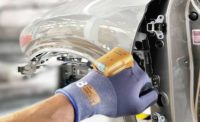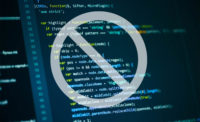The mottled spread-spectrum bar code resembles the marbled cover of a composition notebook. It contains embedded correction parameters, and can encrypt and limit access to various levels of information. The bar code can be reset during inventory, and it can be used to track elapsed time, temperature or environmental conditions.
In fact, the code doesn’t actually have to be seen as a distinct bar code. It can be hidden in a logo, it can be designed to expire after a period of time, or it can indicate suspicion of tampering when used as a seal.
Each bit of data is encoded pseudo-randomly across the entire bar code. All of the encoded bits are then overlaid to form a grayscale, or analog, bar code image. Because each bit of data is spread redundantly across the bar code, all of the data can be recovered, even when some or most of the barcode is missing. It reveals its embedded information when scanned by a regular CCD camera.
On the other hand, the average person can’t decode the encrypted data or counterfeit a copy. Higher-end versions can include self-assembled, luminescent particle fingerprints; temperature-sensitive gels or inks that can be reset by changing temperature; and chemically sensitive inks to indicate spoilage.
"Manufacturing, inventory, shipping and control of precious or perishable materials could all benefit from this application," says Scott Vaupen of Sandia’s Business Development Support Department.



